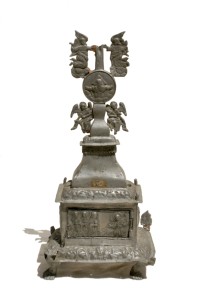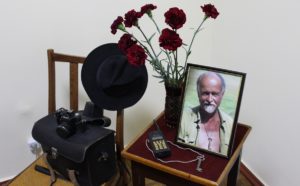By the 175th anniversary of Basil Tarnowska
 Among the antiquities Ukrainian Vasily Tarnowska separate ranked cult objects: darohranilnitsі, potiri, candlesticks, Lampadus, censers, settings Gospels, dishes, altar and neck crosses, icon in robes, Panagia etc.. Some of the monuments have holdings records or labels, associated with the names of famous historical figures. So, from the former church Zaporozhye "Old-Kodakoho village" Katerynoslavs'ka province came three liturgical silver items - cup for Communion, paten and zvizdytsya, donated Zaporozhian Ataman Ivan smoking dressmaker, and two silver lamps shirts: "Zdhlana syya lyanpa Cossack: shchh Zaporozhye Fєdorom Shumenkom kurenya titarєvskogo ", icon in a silver robe, belonging to Colonel Vasily Polubotko, pectoral cross Chernihiv archbishop Ambrose Dubnevycha (1742–1750), extracted from the Crypt, which fell against the wall of the cathedral Borisoglebskii. On the Uniate churches came four candlesticks, according to the detailed description, they are almost identical, on one of the specified year in Latin "Anno MDCCXIII" (1713). On prevelikij Zal, listed monuments lost and indeed with 80 metalpalstic collection of sacred objects currently in the collection of Chernihiv Historical Museum named after VV. Tarnowska detected only 18, a few things, described too generalized, can be attributed with caution.
Among the antiquities Ukrainian Vasily Tarnowska separate ranked cult objects: darohranilnitsі, potiri, candlesticks, Lampadus, censers, settings Gospels, dishes, altar and neck crosses, icon in robes, Panagia etc.. Some of the monuments have holdings records or labels, associated with the names of famous historical figures. So, from the former church Zaporozhye "Old-Kodakoho village" Katerynoslavs'ka province came three liturgical silver items - cup for Communion, paten and zvizdytsya, donated Zaporozhian Ataman Ivan smoking dressmaker, and two silver lamps shirts: "Zdhlana syya lyanpa Cossack: shchh Zaporozhye Fєdorom Shumenkom kurenya titarєvskogo ", icon in a silver robe, belonging to Colonel Vasily Polubotko, pectoral cross Chernihiv archbishop Ambrose Dubnevycha (1742–1750), extracted from the Crypt, which fell against the wall of the cathedral Borisoglebskii. On the Uniate churches came four candlesticks, according to the detailed description, they are almost identical, on one of the specified year in Latin "Anno MDCCXIII" (1713). On prevelikij Zal, listed monuments lost and indeed with 80 metalpalstic collection of sacred objects currently in the collection of Chernihiv Historical Museum named after VV. Tarnowska detected only 18, a few things, described too generalized, can be attributed with caution.
Since the works of ecclesiastical antiquity, which is now kept in the museum, draws attention to the pyx with. Vybli Chernihiv region. In the "Catalogue of Ukrainian antiquities collection VV. Tarnowski "its description is presented as: "High, litas, Tin, i angelami, relief carvings and decorations, on four legs ".
Tabernacles were produced, as a rule, Precious metals, more silver. Following goldsmiths, master konvisary also create similar products, using tin and adding to it a portion of lead. In the XVII century. tabernacles had a rectangular tombs, crowned with domes (the collection of VV. Tarnowska were 2 such sights, were listed as myrnytsi). This in 1682 Dr.. was ofirovana vyblivskym Captain Efim pubis to the newly built church in Chernihiv Mykolaiv. In the next century, this type of church plate comes into baroque forms, Recalling tiered architecture, such as the bell tower, decorated with small sculptures.
It is to such works belong konvisarskyh vyblivska ostensorium size 17,5 х 17 х 14 see, which comes from the ancient churches - Nikolaev or Trinity, known since XVII century. and re-laid in the 1770's. Her first tier has the shape of a rectangular sarcophagus, based on four strong paws. Traditionally, its walls played gospel scene: "Agony cup", "Nesinnya Cross" (side walls), "Myrrhbearers at the tomb" (front wall), "Pokladannâ in the homeland" (back wall). The perfection of execution marked all subjects, than "Agony cup", where there are sustained proportions, which significantly reduces the artistic significance of the work. Over sarkofagom zdіymaєtysya high pіramіdalyna smooth krishka h navershyam in viglyadі dvobіchnogo medalyyona, which hammered belt figure of God the Father (facial side) and the Holy Face (reverse). Composition spire crowned with the Risen Christ in the sunshine (the lost). Decorative ornament enhances the attractions of acanthus scrolls, that row cover curbs shelter, pyramids, and strips of cabbage as an echo of gothic motifs. Eight cast of angels, that richly decorated tomb, provided monumental works and completeness. However,, it is damaged and some parts lost (some managed to find in the preparation of publications). У повоєнні роки пам’ятка отримала два інвентарні номери (И- 2604 – власне гробниця, И-2619 – кришка).
За формою, орнаментацією, compositional and iconographic solution vyblivska ostensorium almost similar to, that exhibited at the exhibition XIV Archaeological Congress in Chernihiv 1908 Dr.. The latest comes from the Church of Intercession with. Dyrchyn Horodnya County and assigned Countess P. Uvarov to konvisarskyh works of the eighteenth century. Tabernacles differ only in details, тож можна припустити, що ці твори виконані одним майстром або представниками одного мистецького осередку, найшвидше – київського. Similar works Kiev goldsmiths and konvisariv date from the second third of the eighteenth century.




More Stories
Chernihiv seals from the Radomyshl museum
To the second anniversary of the defense of Chernihiv Oblast
Life is devoted to science